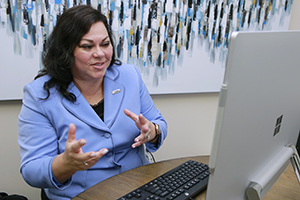
How to Adult: 5 ways to track your spending

5 reasons why couples may have separate bank accounts

Don’t underestimate the importance of balancing your checking account

30-day adulting challenge: Financial wellness tasks to complete in a month

Investment strategies by age

How to build a financial plan that covers your savings and expenses

How I did it: Bought a home without a 20 percent down payment

How I did it: Switched career paths by taking an unexpected pivot

How to save money while helping the environment

Preparing for retirement: 8 steps to take

Multiple accounts can make it easier to follow a monthly budget

Year-end financial checklist

Pet ownership costs: planning for the unexpected

How to sell your business without emotions getting in the way

10 tips on how to run a successful family business

Talent acquisition 101: Building a small business dream team

Make your business legit

How I did it: Turned my side hustle into a full-time job

Costs to consider when starting a business

How to test new business ideas

How to get started creating your business plan

How to establish your business credit score

How to accept credit cards online

How to build a content team

5 financial goals for the new year

How to track expenses

How to manage your finances when you're self-employed

Good money habits: 6 common money mistakes to avoid

How to talk about money with your family

How to build wealth at any age

Retirement income planning: 4 steps to take

Retirement savings by age

Preparing for retirement: 8 steps to take

How I did it: Transitioned from the military to a private sector career

How I did it: Joined a board of directors

5 tips for being a great board member

Transitioning from the military to the civilian workforce

Achieving their dreams through a pre-apprenticeship construction program

How to start investing: A beginner’s guide

11 essential things to do before baby comes

Webinar: Uncover the cost: Starting a family

Preparing for adoption and IVF

Checklist: 10 questions to ask your home inspector

Closing on a house checklist for buyers

Checklist: financial recovery after a natural disaster

How does money influence your planning?

College budgeting: When to save and splurge

How to save money in college: easy ways to spend less

How to gain financial independence from your parents

The A to Z’s of college loan terms

Co-signing 101: Applying for a loan with co-borrower

Practical money skills and financial tips for college students

How to build credit as a student

5 things to know before accepting a first job offer

How I did it: Paid off student loans

Bank Notes: College cost comparison

Tips to earn that A+ in back-to-school savings

How you can prevent identity theft

What to do with your tax refund or bonus

Loud budgeting explained: Amplify your money talk

How to financially prepare for pet costs

Pros and cons of a personal line credit

3 tips for saving money when moving to a new home

Is raising backyard chickens a good idea financially?

3 ways to keep costs down at the grocery store (and make meal planning fun)

5 tips for creating (and sticking to) a holiday budget

Should you buy now, pay later?

Financial checklist: Preparing for military deployment

Friction: How it can help achieve money goals

5 things to consider when deciding to take an unplanned trip

Stay committed to your goals by creating positive habits

Growing your savings by going on a ‘money hunt’

Working with an accountability partner can help you reach your goals

Why a mobile banking app is a ‘must have’ for your next vacation

How to decide when to shop local and when to shop online

Your 5-step guide to financial planning

Webinar: Common budget mistakes (and how to avoid them)

Does your savings plan match your lifestyle?

Uncover the cost: Wedding

Are savings bonds still a thing?

Tips to overcome three common savings hurdles

Adulting 101: How to make a budget plan

Personal loans first-timer's guide: 7 questions to ask

Allowance basics for parents and kids

Mindset Matters: How to practice mindful spending

How can I help my student manage money?

How to manage money in the military: A veteran weighs in

You can take these 18 budgeting tips straight to the bank

Save time and money with automatic bill pay

How to best handle unexpected expenses

Stay on budget — and on the go — with a mobile banking app

Do you and your fiancé have compatible financial goals?

U.S. Bank asks: Transitioning out of college life? What’s next?

U.S. Bank asks: Do you know your finances?

U.S. Bank asks: Do you know what an overdraft is?

Personal finance for teens can empower your child

It's possible: 7 tips for breaking the spending cycle

How to save for a wedding

Here’s how to create a budget for yourself

9 simple ways to save

Dear Money Mentor: How do I set and track financial goals?

Lost job finance tips: What to do when you lose your job

Tips to raise financially healthy kids at every age

Money management guide to financial independence

Money Moments: 8 dos and don’ts for saving money in your 30s

7 financial questions to consider when changing jobs

What’s in your emergency fund?

Certificates of deposit: How they work to grow your money

What you need to know about renting

How to stop living paycheck to paycheck post-pay increase

Practical money tips we've learned from our dads

What I learned from my mom about money

How to increase your savings

Bank from home with these digital features

What financial advice would you give your younger self?

How grandparents can contribute to college funds instead of buying gifts

Using 529 plans for K-12 tuition

Parent checklist: Preparing for college

Consolidating debts: Pros and cons to keep in mind

How to talk to your lender about debt

How to use debt to build wealth

Spring cleaning checklist for your home: 5 budget-boosting tasks

Military homeownership: Your guide to resources, financing and more

Home buying myths: Realities of owning a home

Money Moments: Tips for selling your home

How I did it: My house remodel

Are professional movers worth the cost?

Beyond the mortgage: Other costs for homeowners

Improving your credit score: Truth and myths revealed

Credit: Do you understand it?

